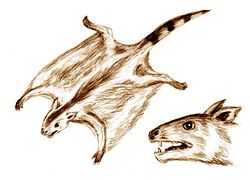Volaticotherium
| Volaticotherium Temporal range: Middle or Late Jurassic, 164Ma | |
|---|---|
 | |
| Life restoration | |
| Scientific classification | |
| Kingdom: | Animalia |
| Phylum: | Chordata |
| Class: | Mammalia |
| Order: | †Eutriconodonta |
| Family: | †Triconodontidae |
| Subfamily: | †Alticonodontinae |
| Genus: | †Volaticotherium Meng et al., 2006 |
| Type species | |
| †Volaticotherium antiquum Meng et al., 2006 | |
Volaticotherium antiquum was an actively mobile ancient gliding insectivorous mammal that lived in what would become Asia during the Jurassic period, around 164 mya. It is the only member of the genus Volaticotherium.
It had a gliding membrane similar to a modern-day flying squirrel. The teeth of Volaticotherium were highly specialized for eating insects, and its limbs were adapted to living in trees. The gliding membrane (patagium) was insulated by a thick covering of fur, and was supported by the limbs as well as the tail. The discovery of Volaticotherium provided the earliest-known record of a gliding mammal (70 million years older than the next oldest example),[1] and provided further evidence of mammalian diversity during the Mesozoic Era.
The phylogenetic analysis conducted by the authors of the description of Volaticotherium antiquum recovered it as the sister taxon of the clade that contained, among other taxa, eutriconodonts, multituberculates, spalacotheriid and tinodontid "symmetrodontans", dryolestids, metatherians (including marsupials) and eutherians (including placental mammals). As the analysis didn't place Volaticotherium within any of the previously known main groups of Mesozoic mammals, the authors of its description erected a separate family Volaticotheriidae and order Volaticotheria for it.[2] However, Zhe-Xi Luo (2007) mentioned that Volaticotherium might actually be a eutriconodont.[3] This was eventually confirmed by the phylogenetic analyses conducted by Leandro C. Gaetano and Guillermo W. Rougier (2011, 2012); these analyses recovered Volaticotherium antiquum as a eutriconodont that belonged to the family Triconodontidae and subfamily Alticonodontinae, and was particularly closely related to the genera Argentoconodon and Ichthyoconodon.[4][5]
The only known fossil of Volaticotherium was recovered from the Daohugou Beds of Ningcheng County, Inner Mongolia, China. The age of the Daohugou Beds is currently uncertain and the subject of debate, but most studies suggest an age of around 164 plus or minus 4 million years ago.[6] The description was published in an issue of the journal Nature.[2]
References
- ↑ Smithsonian Magazine (2007). "Wild Things: Life As We Know It". Smithsonian Magazine. Retrieved 2008-02-22.
- ↑ 2.0 2.1 Meng, J., Hu, Y., Wang, Y., Wang, X., Li, C. (Dec 2006). "A Mesozoic gliding mammal from northeastern China". Nature 444 (7121): 889–893. Bibcode:2006Natur.444..889M. doi:10.1038/nature05234. PMID 17167478.
- ↑ Zhe-Xi Luo (2007). "Transformation and diversification in early mammal evolution". Nature 450: 1011–1019. Bibcode:2007Natur.450.1011L. doi:10.1038/nature06277. PMID 18075580.
- ↑ Leandro C. Gaetano and Guillermo W. Rougier (2011). "New materials of Argentoconodon fariasorum (Mammaliaformes, Triconodontidae) from the Jurassic of Argentina and its bearing on triconodont phylogeny". Journal of Vertebrate Paleontology 31 (4): 829–843. doi:10.1080/02724634.2011.589877.
- ↑ Leandro C. Gaetano and Guillermo W. Rougier (2012). "First Amphilestid from South America: A Molariform from the Jurassic Cañadón Asfalto Formation, Patagonia, Argentina". Journal of Mammalian Evolution 19 (4): 235–248. doi:10.1007/s10914-012-9194-1.
- ↑ Gao, K. -Q.; Shubin, N. H. (2012). "Late Jurassic salamandroid from western Liaoning, China". Proceedings of the National Academy of Sciences 109 (15): 5767–72. doi:10.1073/pnas.1009828109. PMC 3326464. PMID 22411790.
- Meng, J.; Hu, Y.-M.; Wang, Y.-Q.; Wang, X.-L.; Li, C.-K. (2007). "Corrigendum: A Mesozoic gliding mammal from northeastern China". Nature 446 (7131): 102. Bibcode:2007Natur.446Q.102M. doi:10.1038/nature05639.